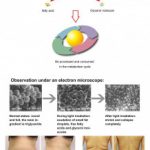Acne is a common skin condition that affects millions of people worldwide. While several treatments exist for acne, light therapy is a non-invasive and effective option that has gained popularity in recent years. Light therapy involves exposing the skin to specific wavelengths of light to reduce inflammation and kill bacteria that cause acne. But what color light therapy is best for acne? In this article, we will explore the science behind light therapy for acne and dive into the different colors of light used in this treatment.
Color light therapy for acne is a popular treatment that uses different wavelengths of light to target skin bacteria and reduce inflammation in the affected areas. This therapy can be performed with various types of light, including blue light, red light, and combination light treatments. In this article, we will explore the use of color light therapy for acne, its effectiveness, benefits, and potential side effects.
Contents
Understanding Light Therapy for Acne
Light therapy, also known as phototherapy, is a type of treatment that uses specific wavelengths of light to treat various skin conditions. The light penetrates the skin’s surface and reaches the deeper layers, where it stimulates cellular activity and promotes healing. For acne, light therapy works by killing the bacteria that cause acne and reducing inflammation in the skin.
There are different types of light therapy for acne, each using a different color of light. Blue light therapy and red light therapy are the most common types of light therapy for acne. Blue light therapy targets the bacteria that cause acne, while red light therapy reduces inflammation and promotes healing.
Blue Light Therapy for Acne
Blue light therapy is a type of light therapy that emits a blue wavelength of light. It works by killing the bacteria that cause acne, specifically Propionibacterium acnes, which is responsible for inflaming the sebaceous glands and causing acne.
Studies have shown that blue light therapy can significantly reduce acne in as little as four weeks. It is a safe and non-invasive treatment that does not cause scarring or damage to the skin. However, blue light therapy is not recommended for people with severe acne or cystic acne, as it may not be as effective in treating these conditions.
Red Light Therapy for Acne
Red light therapy is a type of light therapy that emits a red wavelength of light. It works by reducing inflammation in the skin and promoting healing.
Studies have shown that red light therapy can significantly reduce acne and improve the overall appearance of the skin. It also has anti-aging benefits, as it promotes collagen production and reduces wrinkles and fine lines.
Red light therapy is a safe and non-invasive treatment that does not cause scarring or damage to the skin. However, it may not be as effective in treating severe acne or cystic acne.
Combination Light Therapy for Acne
Combination light therapy is a type of light therapy that uses both blue and red wavelengths of light. It works by targeting both the bacteria that cause acne and the inflammation in the skin.
Studies have shown that combination light therapy can significantly reduce acne and improve the appearance of the skin. It is a safe and non-invasive treatment that does not cause scarring or damage to the skin.
Blue Light Therapy for Acne
Blue light therapy is a type of light therapy that emits a blue wavelength of light. It works by killing the bacteria that cause acne, specifically Propionibacterium acnes, which is responsible for inflaming the sebaceous glands and causing acne. Blue light therapy is effective in treating mild to moderate acne and is a safe and non-invasive treatment that does not cause scarring or damage to the skin.
Blue light therapy is typically administered in a series of treatments, with each session lasting approximately 15 minutes. The number of treatments required depends on the severity of the acne and the individual’s response to the treatment.
One study found that blue light therapy reduced acne by 60% in four weeks. Another study found that a combination of blue and red light therapy reduced inflammatory acne lesions by 76% after four weeks of treatment.
Despite its effectiveness, blue light therapy is not recommended for people with severe acne or cystic acne, as it may not be as effective in treating these conditions.
Red Light Therapy for Acne
Red light therapy is a type of light therapy that emits a red wavelength of light. It works by reducing inflammation in the skin and promoting healing. Red light therapy is effective in treating inflammatory acne and is a safe and non-invasive treatment that does not cause scarring or damage to the skin.
Red light therapy is typically administered in a series of treatments, with each session lasting approximately 15-30 minutes. The number of treatments required depends on the severity of the acne and the individual’s response to the treatment.
One study found that red light therapy reduced acne by 77% after 12 weeks of treatment. Another study found that a combination of blue and red light therapy reduced inflammatory acne lesions by 76% after four weeks of treatment.
Red light therapy also has anti-aging benefits. It promotes collagen production, which reduces the appearance of wrinkles and fine lines. Red light therapy can also improve the texture and tone of the skin, leaving it looking more youthful and radiant.
Key Takeaway: Both blue light therapy and red light therapy are effective and safe options for treating acne. Blue light therapy targets the bacteria that cause acne, while red light therapy reduces inflammation and promotes healing. Combination light therapy, which uses both blue and red wavelengths of light, is also effective in treating acne. The number of treatments required depends on the severity of the acne and the individual’s response to the treatment. While these therapies do not cause scarring or damage to the skin, they may not be as effective in treating severe or cystic acne.







